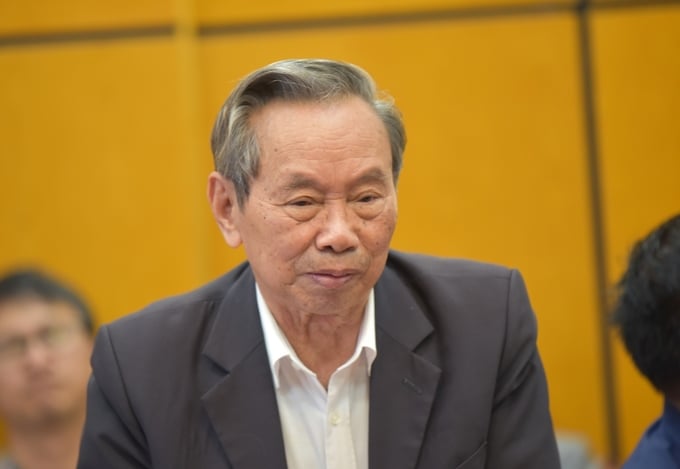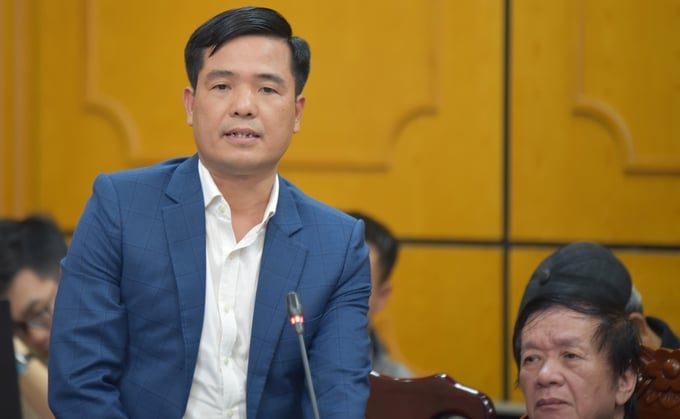May 25, 2025 | 20:57 GMT +7
May 25, 2025 | 20:57 GMT +7
Hotline: 0913.378.918
May 25, 2025 | 20:57 GMT +7
Hotline: 0913.378.918
Sharing his views on solutions to ensure water security in Hanoi’s western region, Professor Nguyen Quang Ngoc – Vice President of the Vietnam Historical Science Association – recalled that in the Proclamation on the Transfer of the Capital, King Ly Thai To wrote: "Tiền giang sơn hưởng bội chi nghi" (which can be understood as: The capital rests between the Tan Vien and Tam Dao mountains, overlooking the Red River). Thus, the Red River became the “lifeline” of Thang Long’s development.
During the French colonial period, a road system was built around the Red River. In recent times, however, there has been a tendency to turn away from the river, hiding behind the dike. When major floods occur, some argue that it is right to do so, to stay behind the dike and turn our backs on the river.

Professor Nguyen Quang Ngoc, Vice President of the Vietnam Historical Science Association, discusses the importance of addressing pollution in Hanoi’s inner-city rivers. Photo: Minh Phuc.
"In reality, our ancestors were not so timid. They embraced the river, making it the center of all activities, including economic, cultural, and social. Today, in Hanoi’s urban planning, I see a promising shift. We are once again looking toward the Red River, recognizing it as the central axis, connecting its eastern and western tributaries."
He further asserted that Hanoi cannot develop sustainably unless the Red River and its tributaries are restored to their natural flow, as they have existed for thousands of years. Without solutions to address river pollution, Hanoi cannot achieve true culture, civilization, or modernity.
The historian believed that sooner or later, the Red River must be given top priority. Citing the data presented by Professor Dao Xuan Hoc and scientists from the Institute of Water Resources Planning, Professor Nguyen Quang Ngoc was surprised that sand mining had lowered the water level of the Red River by 4,5 meters. He said: “It is our fault. We have forgotten the Red River. We have let sand bandits destroy the Red River to a terrifying extent. Now there must be a way to stop it.”
The Vice President of the Vietnam Historical Science Association said that once he and Professor Dao Xuan Hoc surveyed the Red River, every few hundred meters there were sand mountains, sand mountains on top of each other. If we let the river be destroyed like this, no matter how many projects we build, it will still be damaged in the end. He also emphasized that providing solutions to ensure water security for the West of Hanoi is also a comprehensive solution for Hanoi to develop sustainably, not just a story about the irrigation industry.
Answering Professor Nguyen Quang Ngoc’s concern of whether building a dam on the Red River will affect flood discharge during the rainy and stormy season, Professor Truong Dinh Du, former Deputy Director of the Vietnam Institute of Water Resources, author of many research topics on river construction technology, affirmed: In the past, when mentioning the two words “dam” on the Red River, people were very concerned, even did not dare to think about it. Because the Red River flood is extremely dangerous, it is a particularly important national security issue, while many people think that a dam is a structure buried in the ground, occupying a lot of the riverbed. But now, we have many technologies to build dams on the Red River, both mobile and fixed dams, with low cost and ensuring absolute flood discharge.

Professor Truong Dinh Du - former Deputy Director of the Vietnam Institute of Water Resources, author of many research topics on river construction technology. Photo: Minh Phuc.
The most typical is the technology of raising the gate by hydraulic cylinders. The bottom of the dam is made in the form of a box, placed at the bottom of the river (the top of the box is level with the bottom of the river). In the dry season, when there is a lack of water, when necessary, the hydraulic cylinder can be used to raise the gate to raise the water. At the end of the dry season, we only need to lower the gate close to the bottom of the river to return the entire flood discharge area to the Red River. Building a dam with this technology is absolutely safe, but the upper part cannot be combined with a bridge across the river.
There is another option for building a dam, which is to build reinforced concrete pillars in the riverbed (like bridge pillars), the distance between the pillars is 60m to attach the gate, and combine it with the bridge above. And at the dam construction location, we expand the cross-section of the riverbed, at the end of the dry season, we only need to pull up the gate to ensure that it does not affect the flood discharge flow. In the world, there is already a dam with a gate width of 99m, so Vietnam can absolutely do it.
According to Professor Truong Dinh Du, it must be affirmed that the Red River is not lacking water (because there is a hydroelectric reservoir that regularly releases water), but the water level is lowered due to the deep channel. Therefore, building a dam will not affect the downstream, because the amount of water taken into the tributaries is insignificant. Therefore, if a dam is built on the river, it will only be beneficial and will not cause any major harm here.
On behalf of Hanoi city leaders, sharing about solutions to ensure water security in the West Hanoi area, Mr. Nguyen Dinh Du - Head of the Department of Irrigation and Disaster Prevention (Department of Agriculture and Environment) - said that Hanoi’s viewpoint is that all research and planning that have been approved, the city would be determined to implement.
For example, when the idea of building Xuan Quan dam on the Red River and Long Tuu dam on the Duong River arose, Hanoi City paid attention and gave instructions. We have collected information to consider whether it can be included in the public investment plan or not, and have made a proposal to the Capital Planning, but currently this Appendix of the Planning has not been approved. As for the two dams on the Red River and Duong River, further research is still needed.

Mr. Nguyen Dinh Du - Head of the Department of Irrigation and Disaster Prevention (Hanoi Department of Agriculture and Environment. Photo: Minh Phuc.
“Our point of view is that if dams are built on the Red River and Duong River only to supply water to Xuan Quan and Long Tuu sluices, Hanoi will not agree, because then the water source will only serve Hung Yen and other localities, Hanoi will not benefit from those dams. Therefore, research and design units need to calculate the construction of Xuan Quan dam at an elevation of +4.5m or higher to be able to raise water, supplying water to Cam Dinh sluice (bringing water to Day River, Nhue River...). As for building a higher dam to raise water to Trung Ha station (Ba Vi district), further calculations are needed,” Mr. Nguyen Dinh Du suggested, trying to determine the dam location and dam elevation as soon as possible. If the dam location is located in Hanoi, the city can also invest because the city budget can handle it.
Regarding the idea of taking water from the Da River, the Head of the Hanoi Department of Irrigation and Disaster Prevention agreed that the Da River dam only serves to actively supply water for the Tich River, while the Red River dam serves the water source for the Day River and below, which is more suitable.
Professor Nguyen Quoc Dung - Vice President of the Vietnam National Committee on Large Dams and Water Resources Development - said that recently we have paid a lot of attention to the Mekong Delta, but it is time for the State to pay proper attention to the Red River Delta.
Regarding the issue of river pollution in the West of Hanoi, Mr. Dung's point of view is that "Hanoi not only needs to invest without regret, but also needs to invest at a level commensurate with the capital. The construction of a field pumping station to treat river pollution is only a temporary solution, and cannot be done in the long term."
Translated by Quynh Chi
/2025/05/25/4127-3-073637_820.jpg)
(VAN) Thanks to the promotion from an FAO-implemented project, vegetable production in greenhouses in Moc Chau has seen strong development, from 1.5 hectares in 2021 to nearly 50 hectares in 2024.

(VAN) FAO has recently supported USD 140,000 to implement the project 'Risk mitigation human-animal interface risks through disease control initiatives in pig farming.'

(VAN) The People's Committee of Tra Vinh province has approved an adjustment to the investment policy for the Green Hydrogen Plant project, increasing its area to approximately 52.76 hectares.
![Reducing emissions from rice fields: [2] Farmers’ commitment to the soil](https://t.ex-cdn.com/nongnghiepmoitruong.vn/608w/files/news/2025/05/05/dsc08881jpg-nongnghiep-140632.jpg)
(VAN) Clean rice cultivation model in Thuong Tan commune, Bac Tan Uyen district, is assisting local residents in achieving sustainable agriculture by substantially reducing costs, increasing productivity, and protecting the environment.

(VAN) At the conference to disseminate Resolution No. 68, AgriS introduced its digital agricultural ecosystem and reaffirmed its commitment to accompanying the Government in promoting private sector development and sustainable agriculture.

(VAN) 'Blue Ocean - Blue Foods' initiative is designed to restore marine ecosystems and establish sustainable livelihoods for local communities by cultivating a minimum of 1,000 hectares of cottonii seaweed in the first three years.
/2025/05/21/4642-3-112707_603.jpg)
(VAN) The V-SCOPE project has made direct contributions to three out of six pillars of the Comprehensive Strategic Partnership between Vietnam and Australia.